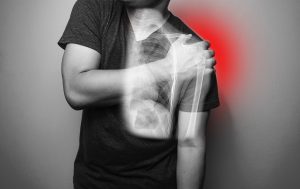11 Jul DAMAGED SHOULDER: STEM CELL TREATMENT OR SURGERY?
Signs and symptoms like pain, stiffness, weakness, and so on are common indicators of a damaged shoulder. Injury to the shoulder can result from many causes like athletic activities, excessive or repeated motion, accidents, and other injuries. Damaged shoulders result from injuries that may affect the muscles, ligaments, tendons, or bones of the shoulder joints. The damaged shoulder is a common condition managed by orthopedics and management may include; physical therapy, pain relief, and surgery.

Stem cell treatment has shown great promise in orthopedic medicine and experts predict that advanced stem cell therapy may take the place of surgical therapy for damaged shoulders in the nearest future.
What are the possible causes of shoulder pain?
The shoulder is made up of two joints that help it maintain its flexibility and perform its functions. Shoulder injuries may affect any of these joints resulting in the symptoms and signs of shoulder damage. In other cases, medical conditions like osteoarthritis, rheumatoid arthritis, and other medical conditions may affect several joints or areas in the body which could including the shoulders.
The most common cause of shoulder pain is rotator cuff tendinitis. This condition is caused by an inflammation of the tendons. The cause of shoulder pain in this condition is the impingement of the rotator cuff on the acromion and humeral head.
Sometimes, pain may be referred to the shoulder from other injured parts of the body like the neck or biceps. Other causes of shoulder pain include; bursitis, bone spurs, dislocation of the shoulder joints, fractured humerus, injury resulting from overuse of the shoulder joints, spinal cord injury, and so on.
Can stem cells repair shoulder damage?
Scientists continue to explore the potential of stem cell treatment in the management of different medical conditions. Advanced stem cell therapy shows significant promise and is being considered a replacement for various conventional therapeutic interventions like surgery, especially in the field of orthopedic medicine. The process of natural healing for a damaged shoulder is complex but scientists intend to leverage the healing ability of stem cells to achieve a cure for shoulder damage.
Several human studies have attempted to use different strategies to apply stem cells in the treatment of shoulder problems. Experimental studies have shown great promise but human studies are still ongoing. Some clinical trials have been able to achieve significant healing for shoulder injuries like rotator cuff tears. There is limited literature on the clinical use of stem cells to repair damaged shoulders; however, available experimental results and reports from clinical trials show that stem cells can enhance healing in damaged joints. Further research will be required to see how the unique characteristics of stem cells can be employed in the management of damaged shoulder.
How does stem cell treatment work versus surgery?
Surgery has been recommended for a very long time as the last resort in the management of shoulder injuries like rotator cuff injuries. However, with the recent developments in modern medicine, many orthopedic specialists have been compelled to question its efficiency as compared to advanced stem cell therapy.
Surgery is the popular intervention for shoulder injuries and it is essentially a surgical repair of the shoulder by an orthopedic surgeon. After shoulder surgery, patients will need several months of physical rehabilitation to restore a good level of functionality to the shoulder. Surgical repairs are invasive procedures and require a high degree of expertise to cut and renovate the complex tissues making up the shoulder joints. There is a high potential for this surgery to fail or result in irreversible damage to tendons or nearby nerves. There is also a high risk of suffering another injury following a surgical repair.
Advanced stem cell therapy for damaged shoulders aims to significantly reduce inflammation and promote rapid natural healing and regeneration of damaged tissues. Modified stem cells can be introduced into the affected shoulder using a less invasive procedure to maximize the body’s healing potential and stimulate the production of tissue-specific cells that become any type of tissue the body needs.
Modern medicine may favor the use of stem cell treatment because of the shorter recovery time, the less invasive procedure, natural healing abilities, and the degree of recovery it offers patients.

Which stem cell therapy treatment center should you choose?
Before choosing a stem cell treatment center, ensure that it is owned by a licensed physician and the procedures are carried out by trained specialists. It is recommended to use a center that offers primarily a treatment for orthopedic injuries and performs image-guided procedures.


No Comments